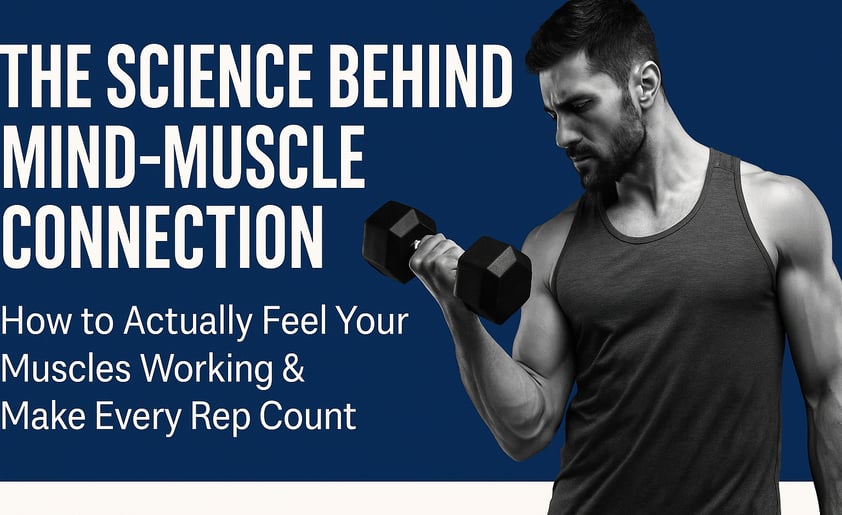How to Master the Mind-Muscle Connection: 5 Proven Techniques to Boost Muscle Growth
Discover how to build a stronger mind-muscle connection and unlock better results in every workout. Backed by science, this guide breaks down simple techniques, expert tips, and top tools to enhance muscle activation and performance.
5/13/20253 min read


The Science Behind Mind-Muscle Connection
How to Actually Feel Your Muscles Working & Make Every Rep Count
You ever hit a workout and just go through the motions? You finish the set, but don’t really feel it in the muscles you were supposed to be training? That’s where the mind-muscle connection (MMC) comes in — and it’s one of the most underrated ways to level up your training, whether you’re brand new or been in the gym for years.
In this article, we’re breaking down what the mind-muscle connection really is, how to strengthen it, what the science says, and a few helpful tools (with product recs) to help you get more out of every workout — without lifting heavier or longer.
What Is the Mind-Muscle Connection?
It’s pretty simple: the mind-muscle connection is all about being mentally locked in to the muscle you're trying to work. So instead of just doing a bicep curl, you’re feeling your bicep curl — focusing on that squeeze, the stretch, and every part of the rep.
And yeah, science backs it up. A study in the Journal of Strength and Conditioning Research showed that people who focused on their chest during bench press had more chest activation than those who didn’t. Another study found that just mentally visualizing a movement could boost strength and muscle performance over time.
Basically, if you train your brain to focus, your muscles will follow.
1. Slow Down Your Reps
One of the easiest ways to build that connection is to just slow it down. Controlled reps force you to pay attention. You’ll start noticing where your form breaks down, when a muscle starts kicking in, and how that movement actually feels.
Resistance Bands
[Whatafit Resistance Bands Set]
Bands are perfect for slowing things down and isolating muscles. Unlike weights, they give you tension the whole way through the movement, which makes it way easier to stay locked in on the muscle you’re working.
Why it works: You’ll feel every inch of the rep — and that’s exactly what builds the connection.
2. Start Lighter, Feel More
You don’t need to go heavy to make gains. In fact, going too heavy too soon makes it harder to feel what’s working — you start compensating with momentum or other muscles.
Using lighter weights gives you more control, better focus, and helps you dial in that muscle you’re trying to grow.
3. Visualize Every Rep
Before a set, take 5 seconds to actually picture the muscle working. For example, if you're doing a row, imagine your lats stretching and then squeezing as you pull. It sounds simple, but that mental imagery lights up the same parts of your brain that physical movement does. Wild, right?
- Biofeedback Sensor
[Flowtime : Biosensing Meditation HeadBand]
This little wearable shows you which muscles are actually firing during your set. It's a solid way to make sure you're activating what you think you're activating.
Why it works: Great for beginners learning proper form or lifters trying to fix imbalances.
4. Iso-Holds: That Extra Squeeze
Try adding a pause at the top of your rep. Let’s say you're curling — when you get to the top, hold it for 2–3 seconds and really squeeze the muscle.
It sounds minor, but that little pause can skyrocket muscle engagement and make lighter weight feel way harder (in a good way).
5. Touch the Muscle (Yep, Literally)
This one’s old school, but it works. Physically touching the muscle while you’re working it helps your brain zero in. So if you're doing glute bridges and lightly press your fingers on your glutes, you’re way more likely to feel them fire. It’s like giving your brain a little GPS.
(Pre-Workout Wake-Up) Foam Roller
[TriggerPoint GRID Foam Roller]
Using a foam roller before your workout increases blood flow and wakes up the muscles you're about to train. It’s great for activating hard-to-feel muscles like glutes or lats.
Why it works: Helps you loosen up and feel more connected before your first rep.
When Does MMC Work Best?
Mind-muscle connection shines in isolation exercises like curls, glute bridges, flyes, or lateral raises. These moves let you focus on one muscle at a time.
For bigger compound lifts like squats or deadlifts, the connection is still helpful — but it’s harder to isolate a single muscle since a bunch are working together. That’s why a lot of people use lighter, focused warm-up sets to get that connection locked in before jumping into heavy lifts.
Expert Tip: Think Quality Over Quantity
Dr. Jacob Harden, a performance physical therapist, says that improving your neurological control over a movement leads to better performance and fewer injuries. That’s huge — especially if you’re dealing with stubborn muscle groups that just won’t grow, or if you're bouncing back from an injury.
Final Thoughts
Here’s the truth: you don’t need a new workout plan — you just need to pay more attention during the one you’ve already got. The mind-muscle connection isn’t about being perfect or getting super technical. It’s about tuning in, slowing down, and really feeling the work.
So next time you train, pick one exercise, go lighter, slow it down, visualize it, and see what happens. The pump hits different when your brain’s in the set.
FITNESS
Nutrition
WellnesS
info@movebetterco.com
© 2025. All rights reserved | Privacy Policy | Terms & Conditions